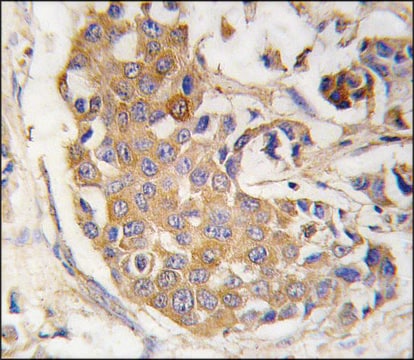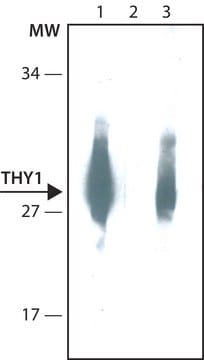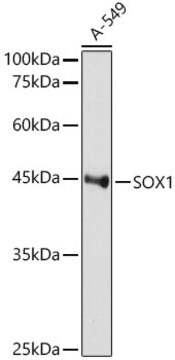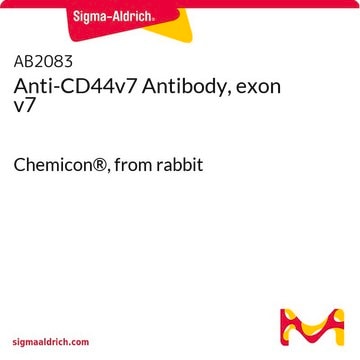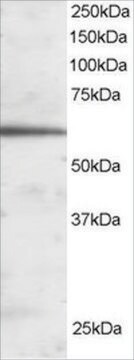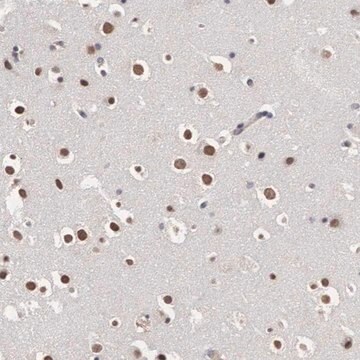07-1673
Anti-SOX1 Antibody
from rabbit, purified by affinity chromatography
Sinonimo/i:
SRY (sex determining region Y)-box 1, SRY-related HMG-box gene 1
About This Item
Prodotti consigliati
Origine biologica
rabbit
Livello qualitativo
Forma dell’anticorpo
affinity isolated antibody
Tipo di anticorpo
primary antibodies
Clone
polyclonal
Purificato mediante
affinity chromatography
Reattività contro le specie
human
Reattività contro le specie (prevista in base all’omologia)
mouse
tecniche
immunohistochemistry: suitable (paraffin)
N° accesso NCBI
N° accesso UniProt
Condizioni di spedizione
wet ice
modifica post-traduzionali bersaglio
unmodified
Informazioni sul gene
human ... SOX1(6656) , SRY(6736)
Descrizione generale
Specificità
Immunogeno
Applicazioni
Epigenetics & Nuclear Function
Transcription Factors
Qualità
Immunohistochemistry(paraffin):
A 1:300 dilution of this antibody was used to detect SOX1 in human epidermis.
Stato fisico
Stoccaggio e stabilità
To reconstitute the antibody, centrifuge the antibody at a moderate speed (5,000 rpm) for 5 minutes. Carefully remove the ammonium sulfate/PBS buffer solution and discard; 10 μL of residual ammonium sulfate solution will not affect the re-suspension of the antibody. Do not let the protein pellet dry, as severe loss of antibody reactivity can occur. Re-suspend the antibody pellet in 100L either standard PBS or TBS (pH 7.3-7.5). DO NOT VORTEX. Mix by gentle stirring with a wide pipet tip or gentle finger-tapping. Let the precipitated antibody rehydrate for 1 hour at 25°C prior to use. Small particles of precipitated antibody that fail to re-suspend are normal. Vials are overfilled to compensate for any losses.
Esclusione di responsabilità
Not finding the right product?
Try our Motore di ricerca dei prodotti.
Codice della classe di stoccaggio
12 - Non Combustible Liquids
Classe di pericolosità dell'acqua (WGK)
WGK 2
Punto d’infiammabilità (°F)
Not applicable
Punto d’infiammabilità (°C)
Not applicable
Certificati d'analisi (COA)
Cerca il Certificati d'analisi (COA) digitando il numero di lotto/batch corrispondente. I numeri di lotto o di batch sono stampati sull'etichetta dei prodotti dopo la parola ‘Lotto’ o ‘Batch’.
Possiedi già questo prodotto?
I documenti relativi ai prodotti acquistati recentemente sono disponibili nell’Archivio dei documenti.
Il team dei nostri ricercatori vanta grande esperienza in tutte le aree della ricerca quali Life Science, scienza dei materiali, sintesi chimica, cromatografia, discipline analitiche, ecc..
Contatta l'Assistenza Tecnica.